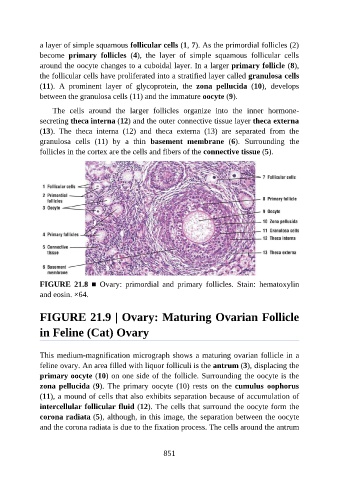Page 852 - Atlas of Histology with Functional Correlations
P. 852
a layer of simple squamous follicular cells (1, 7). As the primordial follicles (2)
become primary follicles (4), the layer of simple squamous follicular cells
around the oocyte changes to a cuboidal layer. In a larger primary follicle (8),
the follicular cells have proliferated into a stratified layer called granulosa cells
(11). A prominent layer of glycoprotein, the zona pellucida (10), develops
between the granulosa cells (11) and the immature oocyte (9).
The cells around the larger follicles organize into the inner hormone-
secreting theca interna (12) and the outer connective tissue layer theca externa
(13). The theca interna (12) and theca externa (13) are separated from the
granulosa cells (11) by a thin basement membrane (6). Surrounding the
follicles in the cortex are the cells and fibers of the connective tissue (5).
FIGURE 21.8 ■ Ovary: primordial and primary follicles. Stain: hematoxylin
and eosin. ×64.
FIGURE 21.9 | Ovary: Maturing Ovarian Follicle
in Feline (Cat) Ovary
This medium-magnification micrograph shows a maturing ovarian follicle in a
feline ovary. An area filled with liquor folliculi is the antrum (3), displacing the
primary oocyte (10) on one side of the follicle. Surrounding the oocyte is the
zona pellucida (9). The primary oocyte (10) rests on the cumulus oophorus
(11), a mound of cells that also exhibits separation because of accumulation of
intercellular follicular fluid (12). The cells that surround the oocyte form the
corona radiata (5), although, in this image, the separation between the oocyte
and the corona radiata is due to the fixation process. The cells around the antrum
851

